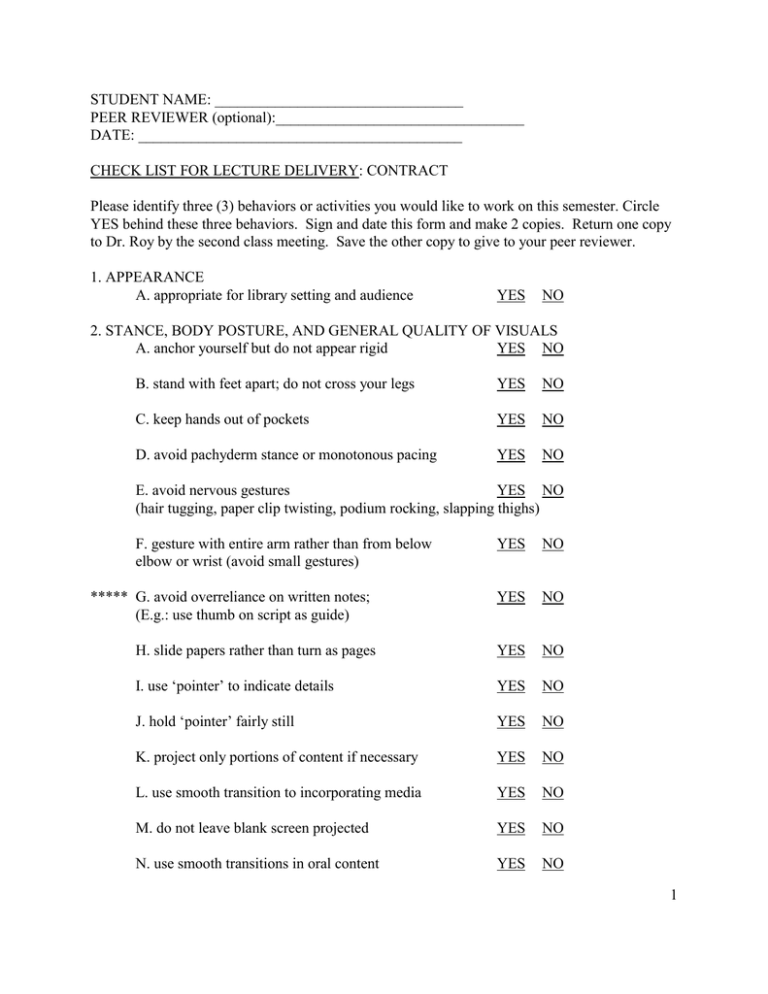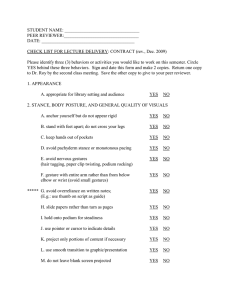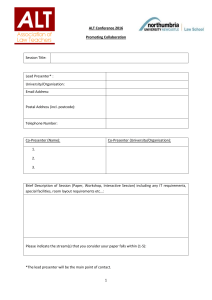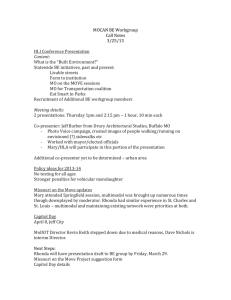Lecture Delivery Contract (pdf)
advertisement

STUDENT NAME: _________________________________ PEER REVIEWER (optional):_________________________________ DATE: ___________________________________________ CHECK LIST FOR LECTURE DELIVERY: CONTRACT Please identify three (3) behaviors or activities you would like to work on this semester. Circle YES behind these three behaviors. Sign and date this form and make 2 copies. Return one copy to Dr. Roy by the second class meeting. Save the other copy to give to your peer reviewer. 1. APPEARANCE A. appropriate for library setting and audience YES NO 2. STANCE, BODY POSTURE, AND GENERAL QUALITY OF VISUALS A. anchor yourself but do not appear rigid YES NO B. stand with feet apart; do not cross your legs YES NO C. keep hands out of pockets YES NO D. avoid pachyderm stance or monotonous pacing YES NO E. avoid nervous gestures YES NO (hair tugging, paper clip twisting, podium rocking, slapping thighs) F. gesture with entire arm rather than from below elbow or wrist (avoid small gestures) YES NO YES NO H. slide papers rather than turn as pages YES NO I. use ‘pointer’ to indicate details YES NO J. hold ‘pointer’ fairly still YES NO K. project only portions of content if necessary YES NO L. use smooth transition to incorporating media YES NO M. do not leave blank screen projected YES NO N. use smooth transitions in oral content YES NO ***** G. avoid overreliance on written notes; (E.g.: use thumb on script as guide) 1 O. make sure text/graphics are focused YES NO P. project content for an appropriate period of time YES NO Q. select appropriate content YES NO R. do not cram too much text onto slides YES NO S. have professional appearing graphics/text YES NO T. avoid turning back to audience YES NO 3. YOUR VOICE A. vary pitch; aim for lower range; practice ALTO or BASS voice YES NO ***** B. volume: talk louder than normal; practice YES NO C. speed: talk more slowly than normal YES NO D. pronunciation: practice, especially difficult words YES NO E. tone: interested; enthusiastic YES NO F. projection: shoulders back, spine straight YES NO G. eliminate overused words: e.g., basically YES NO YES NO I. watch grammatical errors YES NO J. watch so that your voice does not drop at the end of sentences YES NO K. avoid verbalizing small `asides’ to yourself YES NO L. avoid engaging in private asides with co-presenter YES NO M. create smooth transition to co-presenter YES NO N. make references to other content in class YES NO ***** H. eliminate disfluencies (ums, ahs, you knows, tsks, laughter, giggles) 2 O. practice with microphone; listen to previous speaker; test run before beginning; does leaning into mike create undesirable sounds? YES NO YES NO B. introduction should be brief and interesting YES NO C. pause after word or phrase for emphasis YES NO D. speak important words or phrases louder for emphasis YES NO E. repeat important words or phrases but without drilling YES NO F. vary length of sentences YES NO G. intersperse visuals YES NO H. when appropriate, insert personal comments, anecdotes YES NO I. consciously move from one place to another YES NO J. mark pacing into your talk YES NO YES NO B. distribute handout to entire audience YES NO C. introduce handout and its purpose YES NO D. choose simple words and sentences YES NO E. may use appropriate references to popular culture to establish rapport YES NO YES NO B. peppy introduction YES NO C. strong closing YES NO 4. YOUR PACE A. start at high energy level (aggressively) 5. MAKE IT EASY TO FOLLOW YOU ***** A. make structure apparent 6. YOUR CHOICE OF WORDS A. watch jargon 3 D. attention-grabbing phrases YES NO E. action verbs YES NO 7. YOUR TIMING A. start on time YES NO B. end on time YES NO C. make audience aware of organization YES NO 8. EYE CONTACT A. scan: middle, left, right sides of room YES NO 9. YOUR SCRIPT OR NOTES A. hide them YES NO B. keep pages loose; do not staple YES NO C. double or triple space YES NO D. re-type additions; scribbles are hard to read YES NO E. use care in reading from the top to the bottom of your script YES NO YES NO YES NO YES NO B. "What questions do you have?" YES NO C. wait 10 seconds before moving on YES NO D. repeat question if necessary YES NO E. try not to interrupt YES NO F. leave question box for shy questioners YES NO 10. USE OF HUMOR A. use when natural; do not force B. use with caution 11. INTERACTION A. conduct early participatory activity 4 G. gather feedback during breaks YES NO H. do not be afraid to say "I don't know" YES NO I. practice supportive vs. argumentative response YES NO 12. CONSIDER WORSE CASE SCENARIOS 1. sickness 2. last minute changes in scheduling: time, date, room 3. surprise topic 4. getting lost 5. insufficient or malfunctioning equipment 6. hecklers 7. disagreeable panel members 8. losing script; dropping pages 9. late co-presenter 10. co-presenter with weak time management skills 5



